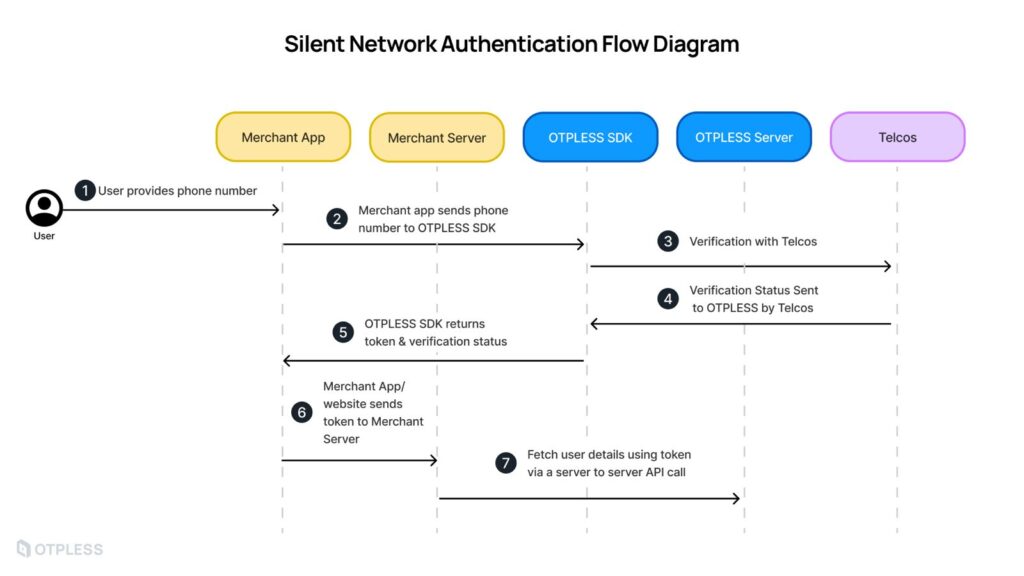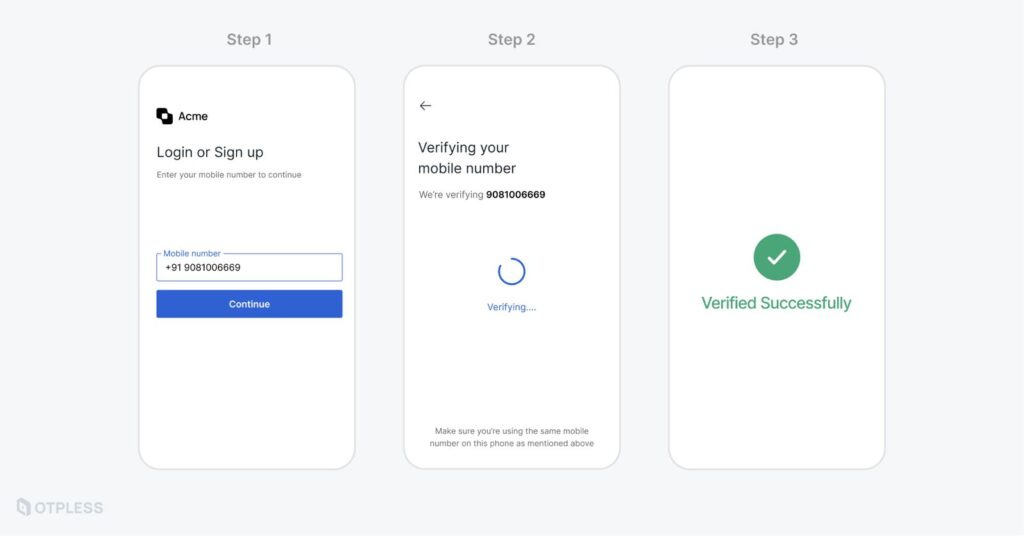Introduction
Silent Network Authentication (SNA) is a secure method of consumer authentication that safeguards end-users, accounts, and transactions without necessitating user wait times or app interruptions. It leverages direct carrier connections to confirm ownership of a phone number in the background, eliminating the need for user input. With SNA, there are no 6-digit passcodes or authenticator app downloads, making it resistant to phishing attempts by fraudsters.
SNA operates on the same authentication system that carriers use for mobile phone calls and data sessions on their networks, providing a high level of assurance for each verified phone number. While the underlying authentication system is well-established and trusted, extending this authentication method to businesses via an API like OTPLESS’s Silent Network Authentication channel is a relatively recent development. SNA is also referred to as “Phone Number Verification” (PNV) or “Header Authentication.”
This blog post will delve into what SNA entails, how it functions, and whether this frictionless authentication approach is suitable for your business, including insights from OTPLESS’s expertise in this domain.
What is the end-user experience with Silent Network Authentication?
The most attractive feature of SNA is that the authentication process happens in the background.
First, the user provides their login credentials. This can either be a phone number or something like an email address that’s linked to a phone number in your application database.
While step #2 is optional, the direct carrier connection and verification can take 1-4 seconds* to complete (still much faster than a one-time passcode flow!). Therefore, we recommend showing the user an interstitial screen while they wait so that the user knows that something is happening in the background to authenticate.
Once the mobile network has authenticated the user, you can redirect them to gated content on your site or application.
How does Silent Network Authentication work?
OTPLESS Silent Network Authentication is used at sign-up, login, or transaction time to validate that a user’s SIM (Subscriber Identity Module) is actively connected to the mobile network and not spoofed or cloned. The SNA technology is built on top of the standardized GSM (Global System for Mobile Communications) authentication.
When a user triggers SNA during login, checkout, or whenever you want your app to perform this verification, the browser or mobile application starts a mobile data session on the device. In order to leverage GSM authentication, SNA must be done using mobile data, not Wi-Fi.
Here’s an overview of how GSM authentication and SNA work on a technical level:

Step 1: The user provides their phone number on the Merchant App.
Step 2: Merchant App sends the phone number to OTPLESS SDK for verification.
Step 3: OTPLESS SDK initiates verification with Telcos (Telecommunication Companies).
Step 4: Telcos verify the phone number and send the verification status to OTPLESS.
Step 5: OTPLESS SDK receives the verification status and returns a token along with the verification status to the Merchant App.
Step 6: The Merchant App/Website sends the token to the Merchant Server.
Step 7: Merchant Server fetches user details using the token via a server-to-server API call.
What are the benefits of Silent Network Authentication?
Silent Network Authentication is an especially useful form of authentication if your company wants to:
- Reduce OTP-related friction: OTPLESS Silent Network Authentication (SNA) stands out as the sole method that verifies phone number possession without requiring extra user input. Witness the efficiency firsthand with a comparison of SMS authentication (left) and OTPLESS SNA (right).

- Reduce customer support costs related to authentication: Excessive friction during authentication prompts users to either abandon the process or seek support, incurring costs for businesses. The seamless nature of OTPLESS SNA eliminates the need for password memorization, OTP waiting, or app downloads, saving valuable time and resources.
- Improve account security posture: While SMS authentication is popular for its global compatibility, it is susceptible to phishing attacks targeting OTPs. Transitioning to OTPLESS SNA mitigates this risk, enhancing security for both your application and its users. Supplementing with SMS authentication and SIM Swap detection provides a comprehensive security approach for a seamless user experience.
What are the limitations of using Silent Network Authentication?
Every authentication method has its pros and cons, and while SNA offers a great frictionless experience, it doesn’t work in all circumstances. Some things to keep in mind include:
- Users must have an active cellular connection on their mobile device (not Wi-Fi) for OTPLESS Silent Network Authentication (SNA) to function effectively. SNA relies on mobile data to initiate the GSM authentication process, which isn’t accessible via Wi-Fi. To ensure SNA works seamlessly, you can prompt users to disable Wi-Fi if they’re using a mobile browser like Safari or Chrome.
- OTPLESS SNA is currently available in 10 countries including the US, Canada, UK, Germany, France, Spain, India, Indonesia, and more. For specific details about coverage and availability, reach out to learn more about OTPLESS’s country coverage.
- Dual SIM devices require additional configuration for OTPLESS SNA. These devices may use two different data networks, requiring the Verify API to perform dual SIM checks and authenticate the user with the correct network. Managing dual SIM scenarios involves obtaining the IP address of the active data session to ensure seamless authentication. To learn more about managing dual SIM configurations and other edge cases, contact OTPLESS for detailed guidance.
Conclusion
Silent Network Authentication (SNA) offered by OTPLESS presents a revolutionary approach to authentication, ensuring enhanced security, reduced friction, and improved user experience. By leveraging direct carrier connections and GSM authentication, OTPLESS SNA eliminates the need for cumbersome OTPs and enhances account security by mitigating phishing risks associated with SMS authentication. While SNA is not without limitations, such as requiring a cellular connection and specific country availability, its benefits far outweigh these considerations, making it a compelling choice for businesses looking to streamline authentication processes while prioritizing security and user satisfaction.
Getting started with OTPLESS Silent Network Authentication
To begin integrating OTPLESS Silent Network Authentication (SNA) into your application, start by thoroughly understanding how SNA works, its advantages, limitations, and technical aspects as outlined in the provided blog post. This foundational knowledge will guide your decision-making during the implementation process. Next, refer to OTPLESS documentation for detailed information, guides, and API references related to Silent Network Authentication.
Familiarize yourself with the integration guidelines and code snippets provided to seamlessly integrate SNA into your app. Contact OTPLESS sales to get approved for using the Silent Network Authentication service, discuss pricing plans, and receive guidance on the onboarding process. Once approved, implement SNA in your application following the integration guidelines provided by OTPLESS. Test and validate the authentication flow thoroughly to ensure functionality, reliability, and security.
Launch OTPLESS SNA in your production environment and continuously monitor authentication processes, user feedback, and system performance for optimizations and improvements. Stay informed about OTPLESS announcements, product updates, and best practices related to Silent Network Authentication to leverage its full potential for your application’s authentication needs.
For more information about the Verify API implementation, check out the documentation. Then, reach out to sales to get approved and start building.


Very interesting info!Perfect just what I was searching
for!Blog range